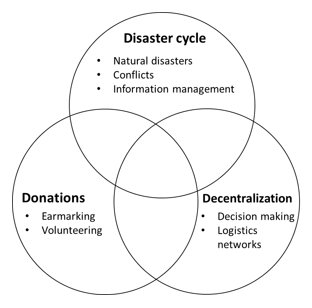Research
Editorial Positions
- Guest Editor, Special Issue on Humanitarian Operations and the UN Sustainable Development Goals. Deadline for submissions: January 31, 2020. Call for papers:
http://poms.org/SI%20on%20UNSDGs%20POM%20Journal.pdf - Senior Editor at the Disaster Management Department, Production and Operations Management.
- Member of the Editorial Review Board at the Department of Humanitarian Operations, Journal of Operations Management (JOM).
Research Interests

Research Interests. Alfonso J. Pedraza-Martinez. 2019
Disaster Management Cycle
Four phases form the disaster management cycle: preparedness, response, rehabilitation and mitigation. The former two phases belong to relief operations and the latter two phases belong to development operations. Relief operations have short-term duration (months), high urgency, and high uncertainty. Development operations have long-term duration (years), low urgency, and low uncertainty. While relief operations maximize service level subject to a budget constraint, development operations minimize cost subject to an acceptable service level. Humanitarian organizations (HOs) often respond to a disaster somewhere, while they carry out development programs such as food education and healthcare somewhere else.
HO’s operational mix of relief and development leads to challenging research problems. For example, an HO’s decentralized logistics network may increase speed of response to disasters but it may be expensive for the HO’s underfunded development operations. I have worked extensively with HOs and institutional donors engaged in disaster response and development operations including International Committee of the Red Cross (ICRC), International Federation of Red Cross and Red Crescent Societies (IFRC) World Food Programme (WFP), World Vision International (WVI), and Humanitarian Aid and Civil Protection Department of the European Commission (ECHO). In close collaboration with practitioners, I study humanitarian supply chains that support the disaster management cycle.
Donations
Donors are the main source of funds for humanitarian operations. Donors may give cash, non-cash items and time (volunteering). There are mismatches of interests between donos and HOs. Donors reasonably prefer the autonomy to choose what program to fund and HOs respond by allowing donors to earmark their donations to specific programs. However, earmarked funding imposes operational constraints to HOs regarding resource relocation between programs. Moreover, non-solicited donations create bottleneck problems in the logistics of disaster response. Additionally, while volunteers generously donate their time, there may be reliability issues in terms of commitment and skills of volunteers that are challenging to HOs’ disaster management. I study donations in humanitarian operations.
Decentralization
HOs’ headquarters are located either in developed countries or capital cities in developing countries. However, field programs are implemented in remote regions all over the world. HO headquarters and field programs have different supply chain objectives. Headquarters strive to balance logistics costs and service level to beneficiaries. However, field programs are more sensitive to service levels than they are to logistics costs because often they do not internalize all the operating costs. This incentive misalignment is complicated further by expensive monitoring costs. I study decentralization in humanitarian operations.